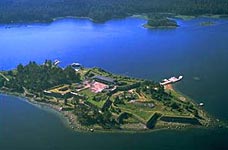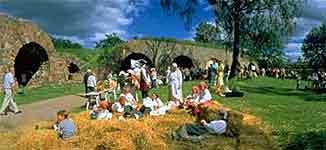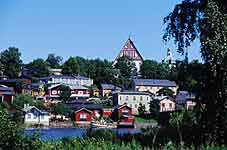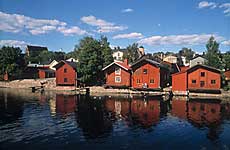Lappeenranta
Lappeenranta is the administrative and cultural capital of South Karelia and the centre of tourism on Lake Saimaa. It is known as the “Town of Lindens” because of the 2,600 Linden Trees planted in the parks and lining the streets. The heart of the historical town is Fortress. It now houses museums, cafés and craft shops but the cavalry tradition is still visible in the cavalrymen that ride through the town regularly in embroidered shirts and red trousers.
Places to see
- The Fortress
- The Churches of Lappeenranta – The are two notable churches. The Orthodox Church within the Fortress built in 1785, and the wooden Lutheran church.
- South Carelian Art Museum
- South Carelian Museum – This museum is housed in part of the town fortress. The history of the town can be seen here and also local peasant costumes.
- Young Officer’s House – Handicraft workshops and Café
- Cavalry Museum – Built in 1772, this is the oldest building in Lappeenranta. It was the Garrison Guardroom for the Finnish Dragoon Regiment. Exhibits include uniforms, weapons and documents.
- Wolkoff House Museum – A merchant Family home from 1870 with museum and guided tours
- Saimaa Canal – This canal connects Lake Saimaa to the Gulf of Finland. It is 43 km long with 8 locks. The best way to see the canal is to take a canal cruise and visit the Saimaa Canal Museum. The museum is located in a former cashier’s residence on the eastern side of the Mälkiä lock at Sulkuvartijankatu 16.
- The Harbour – The harbour area near the fortress is one of the most lively in the summer months. There are cafés, terraces, outdoor concerts and floating restaurants. Cruises from the harbour explore the maze of islands on Lake Saimaa and the Saimaa Canal.
- Market Place – A great place to meet the locals and to shop. Local produce, crafts and traditional foods are available. It is open Monday to Friday from 7am to 7pm and Saturday mornings in the summertime. Flea market open on Sunday mornings.
Lapeenranta to Virolahti
- Take the 387 Road
- Travel for 38 miles (61km)
- At Vaalimaa Turn Right on to 7 Road / E18
- Travel for 5 miles (8km)
- Turn Left on to 351 Road for 1 mile (1.5km)
- Total Distance 43 miles (69km)
Virolahti, incl. Vaalimaa & Virojoki
Virolahti is part of the Eastern Gulf of Finland National Park and is noted for it’s excellent bird watching. There are bird observation towers around this area. Also some very rare species of moth and butterfly can be found here. Due to the clarity and wealth of the waters on this coast, sea fishing is a popular past time.
The tourism centre of Virolahti is in the Vaalimaa district. Here you can find the Tourist office, change currency and shop. The newest shopping centre here is called the Eastgate. Virojoki is the largest population centre of Virolahti. You can find many basic services there: banks, service stations, post office, pharmacy, health centre, specialised shops, schools, library and town hall.
Places to visit
- Harju Manor House & College of Natural Resources (Agriculture and Horticulture) in Ravijoki
- Virolahti Bunker Museum area
- Veli Saarinen Park (designed by Kain Tapper)
- Virolahti Church
Virolahti to Hamina
- Take 351 Road for 1 mile (1.5km)
- Turn Left on to 7 Road / E18
- Travel for 18 miles (29km)
- Total Distance 19 miles (30.5km)
 Hamina
Hamina
In Hamina, a traveller can meet vivid history and culture. The 350-year-old town with an unusual circular town plan has retained its ancient appearance. An 18th century Italian design star-shaped fortress surrounds the town centre. Wooden buildings, churches of various architectural styles and merchant family houses, line the town streets. Guided tours can be booked at the local tourist centre.
The sea is an integral part of Hamina and it is possible to explore the archipelago off the coast. These islands offer the visitor access to the beautiful Finnish wild life and watersports.
The sea, countryside and the unique archipelago with its old fishermen’s villages are characteristic of Hamina. There are almost 400 islands, some of which belong to the Eastern Gulf of Finland National Park. The archipelago offers much to see and experience camping sites with services, and an abundant range of bird species and flora.
Places to visit
- Hamina Town Museum
- Samovar Museum – A private collection of old Russian samovars
- Tammio Local History Museum – In an old fishing lodge, on the island of Tammio, a museum of Island life.
- Reserve Officers’ School Museum – The history and articles of the school since 1920.
- Vehkalahti Local History Museum – Exhibits of boat building, Ski making and local noble families.
- Shopkeepers’ Museum – A shop and merchant’s residence from the turn of the century.
- Orthodox Church of St. Peter & St. Paul – This round church with Byzantine features was designed by Louis Visconti
- Church of Hamina – A Neo-classic Lutheran church designed by C. L. Engel in the style of a Greek temple.
- Hietakylä Cemetery – Established in 1773 beside the sea, the local dignitaries were buried here. The epitaphs contain the name of the deceased person and often a verse from the Bible or a line from a hymn referring to the deceased persons disposition and life-long ambitions. The earliest surviving memorials date from 1809.
- Kirkkojärvi Nature Trail -The 6 km trail circles Lake Kirkkojärvi which is a bird sanctuary and valuable natural environment for native animals, insects and plants. There are a number of information signs along the walk.
- Heinälampi Nature Trail – Located at Turkia in Hamina. The 1.8-kilometre trail has information signs about the natural attractions, campfire site and outdoor toilet.
- The Rampart Road -This is a 4.5 km route based in the fortress of Hamina and in its historic centre. The route is signposted and information boards present the history of Hamina and it’s environment.
Events
- Hamina Tattoo – The international military music event, the, which is held every two years in the Hamina Bastion. The venue for this event is the Hamina Bastion. The Hamina Bastion also hosts many types of summer events: theatre, concerts, fairs, exhibitions and sports.
Campground
- Pitkäthiekat, Vilniemi, – tel. 3459183 Seaside campground with restaurant Open May to Sept.
Hamina to Kotka
- Take 7 Road / E18 towards Kotka, Helsinki
- Travel for 12.5 miles (20km)
- Take Exit for Kotka
- Travel for 1.5 miles (2.5km)
- Total Distance 14 miles (22.5km)
 Kotka
Kotka
Kotka is the largest export in Finland. In this town the sea plays a major role. Many of its inhabitants work in shipping and related business. Kotka is very proud of it’s port and it’s green areas. There are excellent views of the city and the surroundings from the top of the former Haukkavuori water tower. The river Kymijoki, which runs through the city, has some challenging rapids just outside the city.
Places to visit
- The Sapokka Water Garden – Near to the centre of Kotka, the water garden is an oasis of sight and sound.
- Sibelius Park, Keskuskatu Linden Boulevard and Sculpture Park – The park is in the centre of Kotka, at the beginning of the Keskuskatu Linden Boulevard and has been recently restored according to the beautiful 1930’s plan of Paul Olsson.
- Redoubt Kotka & Herb Garden – This beautiful herb garden is set in the Kotka Redoubt, a small fortification. The garden is adapted for the visually impaired and the plants have Braille name tags.
- Kotka Church – A neo-gothic church built in 1898 and designed by Josef Stenback.
- Kymi Church – Empire style church designed by C.L. Engel and built in 1850.
- Haapasaari Church – Wooden church, built in 1858 and used only in the summer.
- St. Nicolas Orthodox Church – The oldest building in Kotka, built in 1799.
- Kotka Maretarium – Seaside aquarium exhibiting water life from the seas and lakes. There are 22 themed aquariums and is a fascinating visit for all the family.
- Langinkoski Imperial Fishing Lodge of Czar Alexander III – This lodge, built in 1889, is set in the Langinkoski Nature Reserve. It has been preserved and tells of life in the Imperial family at the end of the 19th century.
- The Provincial Museum of Kymenlaakso – Local history museum with exhibits showing life in this area from the Stone Age to the present day.
- Museum Ships- The Icebreaker Tarmo is moored in the central harbour of Kotka. At 90 years of age the Tarmo is the world’s oldest icebreaker. The Museum Boat Hall nearby holds the famous Finnish Patrolboat VMV 11 and the lifeboat Haapasaari.
- Stevedoring Museum – A collection of tools and other objects, which tell of life and work in Kotka harbour from 1920-1940
- The Aviation Museum – The Aviation museum at Kymi airfield differs from many other aviation museums in that most of it’s aircraft are kept in flyable condition. The history of Fighter Squadron 34 that operated from Kymi during World War II. Aircraft include Gloster Gauntlet, Mig-21 BIS, Mig-21F, Fouga Magister, Draken, Harakka I, II & III, PIK-5c, Folland Gnat, FW-44 Stiglitz and more. Admission free
- Haukkavouri and Routsinsalmi Look Out Towers
- The Archipelago off the coast of Kotka including Fort Slava ruins – A redbrick circular fortress, completed in 1794, on the island of Kukouri. Visits by waterbus from Sapokka. Varissaari -On the island a monument commemorating the great Naval Battle of Ruotsinsalmi and an exhibition of salvage from the frigate St. Nicholas. Visits by waterbus from Sapokanlahti quay.
- Municipal Art Gallery of Kotka
- Santalahti Nature Trail – A 4 km walk along the seashore
- Karhuvuori Nature Trail – A 5 km walk with several different routes. It goes through marshy areas, along high cliffs and sea inlets. Suitable for bird watchers.
Campground
- Holiday Village Santalahti – Mussalo, Tel. (05) 260 5055. A versatile holiday village next to the town. A camping area of great natural beauty with all conveniences, a soft-sanded beach.
Kotka to Loviisa
- Leave Kotka heading towards Helsinki
- Travel for 1.5 miles (2.5km)
- Take the 7 Road / E18
- Travel for 27 miles (43.5km)
- Total Distance 29 miles (46.5km)
Loviisa / Lovisa
The seaside town of Loviisa was founded in 1745. It is best known for the wooden houses in the Old Town, the fortifications and it’s wharves and marina. Both Finnish and Swedish are spoken in this area because at Loviisa’s foundation, it was part of Sweden on the border with Russia. As a border area, many fortifications were built to protect the town.

Places to visit
- Svartholma Fortress – Located on an island 10km from Loviisa, this fortification is now a museum showing the 250 year history of the fortress and an exhibition area. Guided tours in Finnish, Swedish and English are available, and special pirate tours for children.
- The Old Town – The oldest part of Loviisa still contains wooden buildings that survived a town fire in 1855.
- Degerby Manor – Built in the 17th century, this is the oldest building in Loviisa and now is a restaurant.
- Market Square, Loviisa Church & Town Hall – This central area of Loviisa was mainly designed by Georg Chiewitz in the 1860’s and is considered to be some of his best work.
- Loviisa Orthodox Church & Bell Tower – This church is housed in the former town barracks built in the 1700’s.
- Loviisa Town Museum – The town museum is in the Old Commandant’s House and exhibits include collections relating to the town history, sea-faring, local crafts, the history of the spa and Jean Sibelius; the composer.
- Bonga Castle – An unusual building in the centre of Loviisa, it now houses a museum of the artist Riitta Nelimarkka. More than 200 of her works are on view including drawings, aquarelles, graphic art, collages, woollen/flax reliefs, textile pictures, and art and poetry books.
- Laivasilta Marina Area – From the marina you can watch the bustle of the harbour. There are cafés, restaurants, exhibition areas and a maritime museum.
 Rosen and Ungern Bastions – These bastions on either side of the Vyborg road were built in the mid 1700’s but the planned network of 6 bastions and other fortifications were never completed. Ungern is used in the summer months for events and open-air theatre.
Rosen and Ungern Bastions – These bastions on either side of the Vyborg road were built in the mid 1700’s but the planned network of 6 bastions and other fortifications were never completed. Ungern is used in the summer months for events and open-air theatre.
Campground
- Casino Camping – Kapteenintie 1, 07900 LOVIISA, Finland Tel: +358 (0)50 5363803 2 km from town centre. Open June, July and August. Seaside location
Loviisa to Porvoo
- Head towards Helsinki, Porvoo on 7 Road / E18
- Travel for 18 miles (29km)
- Take Exit Rita
- Travel for 3 miles (5km)
- Total Distance 22 miles (35km)
 Porvoo / Borgå
Porvoo / Borgå
Porvoo, or Borgå as it is known in Swedish, was founded in 1346 and in Finland’s second oldest town. It is a charming town of wooden houses and cobbled streets set on the mouth of a river. It has inspired many artists in it’s history including Johan Ludvig Runeberg (poet), Ville Vallgren (sculptor), Albert Edelfelt (painter) and Tove Jansson (creator of the Moomins).
Places to visit
- The Old Town – With red wooden houses on the waterfront and cobbled streets.
- Porvoo parish church – Porvoo parish church was built in the 13th century as a result of a second crusade headed by Birger Jarl of Sweden.
 The Museum-Home of J.L. Runeberg..
The Museum-Home of J.L. Runeberg..- The Historical Museum and the Edelfelt-Vallgren Museum.
- Doll and Toy Museum of Porvoo.
Camping
- Porvoo Camping Kokonniemi – Camping in a park-like setting +358 (0) 19581967
- Pellinki Caravan – Santasaarentie 128, 07370 Pellinki Tel. 019-540821.
Porvoo to Sipoo
- Leave Porvoo heading towards Helsinki
- Travel for 3 miles (5km)
- Take the 7 Road / E18
- Travel for 5.5 miles (9km)
- Take Exit Sibbo
- Travel on 148 Road for 7 miles (11km)
- Turn Right for Sipoo
- Travel for 1 mile (1.5km)
- Total Distance 17 miles (27km)
Sipoo / Sibbo
This bilingual town of 16,000 people is set on the river Sibbo. Despite it’s proximity to Helsinki, the landscape of river, lake, forest and farming is relatively unspoiled.
Places to visit
- The Old Church – St. Sigfrid’s church was built in the 1400’s
- The New Church – Sibbo parish church, built of red bricks in 1885, was designed by Theodore Decker.
- Östersundom Chapel- A wooden chapel built in the 17th century.
- Nikkilä Community Centre
Sipoo to Vantaa
- Leave Sipoo on 149 Road
- Travel for 0.8 miles (1km)
- Continue for 6 miles (9.5km)
- Continue on 152 Road for 1 mile (1.5km)
- Near Korso, take E75 towards Helsinki
- Travel for 8.5 miles (13.5km)
- Take Exit for Malmi, Mellunkylä
- Take Keha Ring I for 2.7 miles (4km)
- Turn Right for Vantaa
- Travel for 1.5 miles (2.5km)
- Total distance 20 miles (32km)
Vantaa
Vantaa is best known for the international airport, but it also has historic sites such as the Old Sotunki Village, which shows the peaceful Finnish countryside, as it was in the 18th and 19th centuries. Vantaa also has the Heureka Science Center, an exhibition and action centre for all ages, Katrineberg Manor and the Nissbacka Manor Art Exhibition.
Vantaa to Helsinki
- From Vantaa follow signs for Helsinki
- Total Distance 5 miles
 Helsinki
Helsinki
Capital of Finland, Helsinki is a wonderful city full of activity and culture. In this tour we could not do it justice in the short space available, so here are some links to English language websites.
Helsinki to Espoo
- Head towards Espoo
- Turn left onto 110 Road
- Travel for 4 miles (6.5km)
- Turn Left onto Keha Ring III / 50 Road / E50
- Travel for 0.5 mile (0.8km)
- Turn left onto Keha Ring III / 50 Road
- Travel for 2.5 mile (4km)
- Total Distance 12 miles (19.5km)
 Espoo / Esbo
Espoo / Esbo
Espoo as the second largest city in Finland is known as a centre for technology and industry but it combines this perfectly with it’s cultural and natural heritage.
Places to visit
The Espoo Church – With parts of this grey granite church dating to the 1480’s, this is the oldest building in Espoo.
Other churches to visit include the Espoonlahti Church, the Leppävaara church, the Olari Church, the Otaniemi Chapel, the Soukka Chapel, St Herman of Alaska Church and the Tapiola Church.
The Gallen-Kallela Museum – This unusual Art-Nouveau castle-like building houses exhibitions of Akseli Gallen-Kallela in a variety of media and works by other modern artists.
- Waterpark Serena
- Espoo Car Museum – This is the largest and most varied vehicle museum in Finland
- Espoo City Museum – This museum’s main exhibits catalogue the history of Espoo from pre-historic times to the modern day.
- Glimms Farmstead Museum – Set in the buildings of a 19th century farm, this museum offers an insight into life in the past in Espoo.
- The Finnish Museum of Horology – The collection in this museum includes over 4000 clocks and watches and tools for the building and repair of timepieces.
- Helinä Rautavaara Museum – Artefacts, photographs and films collected by the adventurer Rautavaara on her travels around the world. Also includes paintings by Rautavaara
- Nuuksio National Park – A breathtaking mosaic of rocks and canyons, forest ponds, spruces and thickets, the Nuuksio National Park comprises the western part of the Nuuksio lake upland, which is the largest and most important woodland area in the capital region.
- Local Nature Trails – Details of these sign-posted walks can be found at the Espoo tourist office.
- The Archipelago – Over 165 small islands exist off the coast near Espoo. Many can be reached by waterbus or on a guided tour (in Finnish, Swedish and English) of the islands.
Camping
- Espoo Camping Oittaa – Campground on the edge of Lake Bodom +358 (0) 98632585
Espoo to Kirkkonummi
- Head towards Kirkkonumi on Keha Ring III/ 50 Road
- Travel for 5 miles (8km)
- Turn Right onto 51 Road
- Travel for 4 miles (6.5km)
- Turn Right and travel for 1 mile (1.5km)
- Total Distance 10 miles (16km)
 Kirkkonummi / Kyrkslätt
Kirkkonummi / Kyrkslätt
Kirkkonummi has with more than 31.000 citizens. Kirkkonummi archipelago is a large area of both inner and outer archipelago situated off Porkkala peninsula in the central part of the Gulf of Finland. Large areas of open water dominate the archipelago. Most of the islands are small, barren and rocky, but a few are larger and forested. Some islands have small areas of low vegetated shore meadows and shallow lagoons. The main human activity is recreational boating but landing is forbidden on many islands.
Places to see
- Kirkonummi Church – A medieval stone church
- Atelier home of Hvitträsk
- Ragvalds Museum
- Alisgården Museum of Local History and Culture
- Recreational area of Porkkala Peninsula
From Kirkkonumi there are 2 possible routes; an inland route and a coastal route. They converge again at Pohja
